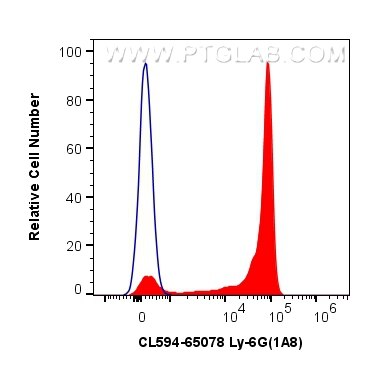Anticorps Monoclonal anti-Ly-6G
Ly-6G Monoclonal Antibody for FC
Hôte / Isotype
Rat / IgG2a, kappa
Réactivité testée
souris
Applications
FC
Conjugaison
CoraLite®594 Fluorescent Dye
CloneNo.
1A8
N° de cat : CL594-65078
Synonymes
Galerie de données de validation
Applications testées
| Résultats positifs en cytométrie | cellules médullaires de souris, |
Dilution recommandée
| Application | Dilution |
|---|---|
| This reagent has been tested for flow cytometric analysis. It is recommended that this reagent should be titrated in each testing system to obtain optimal results. | |
| Sample-dependent, check data in validation data gallery | |
Informations sur le produit
CL594-65078 cible Ly-6G dans les applications de FC et montre une réactivité avec des échantillons souris
| Réactivité | souris |
| Hôte / Isotype | Rat / IgG2a, kappa |
| Clonalité | Monoclonal |
| Type | Anticorps |
| Immunogène | Lignée cellulaire EL-4J transfectée par Ly-6G |
| Nom complet | lymphocyte antigen 6 complex, locus G |
| Numéro d’acquisition GenBank | X70920 |
| Symbole du gène | Ly6g |
| Identification du gène (NCBI) | 546644 |
| Conjugaison | CoraLite®594 Fluorescent Dye |
| Excitation/Emission maxima wavelengths | 588 nm / 604 nm |
| Forme | Liquide |
| Méthode de purification | Purification par affinité |
| Tampon de stockage | PBS with 0.09% sodium azide. |
| Conditions de stockage | Store at 2-8°C. Avoid exposure to light. Stable for one year after shipment. |
Informations générales
Ly-6G (lymphocyte antigen 6 complex, locus G), also known as Gr-1, is a 21-25 kDa, glycosylphosphatidylinositol-anchored protein expressed on myeloid lineage cells in mouse bone marrow (PMID: 8360469). The expression of Ly-6G increases on neutrophils as they differentiate from immature cells in the bone marrow to mature cells in the blood and spleen (PMID: 8890901). Antibodies targeting Ly6G (RB6-8C5 or 1A8) are commonly used in studies aimed at identifying the role of neutrophils (PMID: 23543767). The 1A8 mAb is specific for Ly-6G (PMID: 8360469).
Protocole
| Product Specific Protocols | |
|---|---|
| FC protocol for CL594 Ly-6G antibody CL594-65078 | Download protocol |
| Standard Protocols | |
|---|---|
| Click here to view our Standard Protocols |


